Our Answer Is Partially Correct Try Again For the Following Three Vectors What Is ?
Vector Calculus
38 Vector Fields
Learning Objectives
- Recognize a vector field in a plane or in space.
- Sketch a vector field from a given equation.
- Place a conservative field and its associated potential function.
Vector fields are an important tool for describing many physical concepts, such every bit gravitation and electromagnetism, which affect the behavior of objects over a large region of a plane or of space. They are also useful for dealing with large-scale behavior such as atmospheric storms or deep-sea ocean currents. In this department, we examine the basic definitions and graphs of vector fields then nosotros can study them in more detail in the rest of this chapter.
Examples of Vector Fields
How can nosotros model the gravitational force exerted by multiple astronomical objects? How can we model the velocity of h2o particles on the surface of a river? (Figure) gives visual representations of such phenomena.
(Figure)(a) shows a gravitational field exerted by 2 astronomical objects, such as a star and a planet or a planet and a moon. At any bespeak in the figure, the vector associated with a point gives the internet gravitational strength exerted by the 2 objects on an object of unit mass. The vectors of largest magnitude in the effigy are the vectors closest to the larger object. The larger object has greater mass, so information technology exerts a gravitational force of greater magnitude than the smaller object.
(Figure)(b) shows the velocity of a river at points on its surface. The vector associated with a given point on the river's surface gives the velocity of the water at that point. Since the vectors to the left of the effigy are small in magnitude, the h2o is flowing slowly on that part of the surface. As the water moves from left to right, it encounters some rapids around a rock. The speed of the water increases, and a whirlpool occurs in role of the rapids.
(a) The gravitational field exerted by 2 astronomical bodies on a small object. (b) The vector velocity field of water on the surface of a river shows the varied speeds of water. Ruddy indicates that the magnitude of the vector is greater, so the water flows more than quickly; blueish indicates a lesser magnitude and a slower speed of water flow.
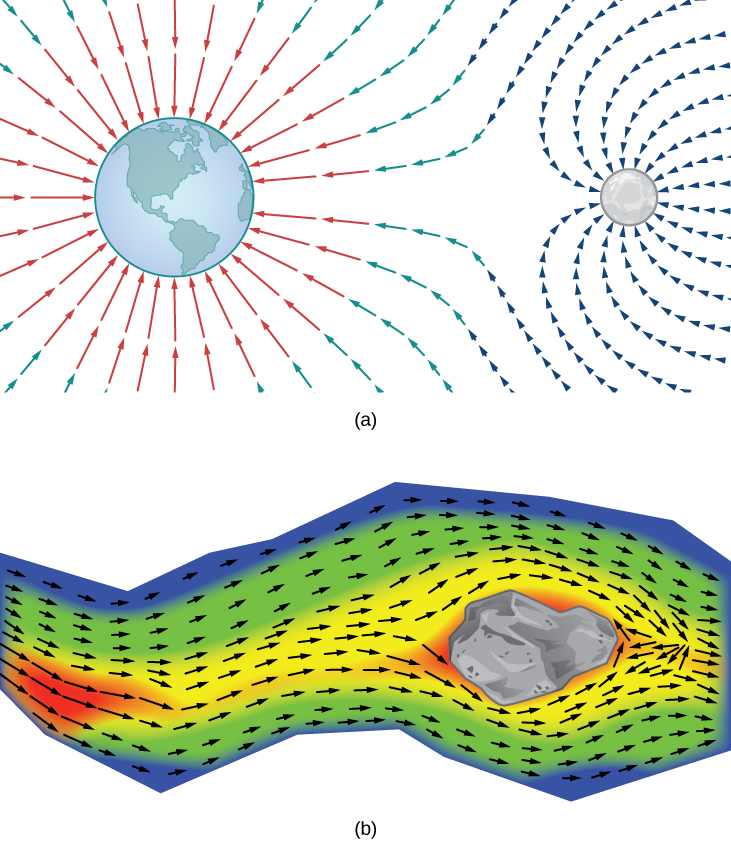
Each figure illustrates an example of a vector field. Intuitively, a vector field is a map of vectors. In this department, we study vector fields in ![]() and
and ![]()
Vector Fields in 
A vector field in ![]() can exist represented in either of ii equivalent ways. The first manner is to use a vector with components that are ii-variable functions:
can exist represented in either of ii equivalent ways. The first manner is to use a vector with components that are ii-variable functions:
![]()
The second way is to employ the standard unit vectors:
![]()
A vector field is said to be continuous if its component functions are continuous.
Finding a Vector Associated with a Given Indicate
Allow ![]() exist a vector field in
exist a vector field in ![]() Note that this is an instance of a continuous vector field since both component functions are continuous. What vector is associated with bespeak
Note that this is an instance of a continuous vector field since both component functions are continuous. What vector is associated with bespeak ![]()
Substitute the point values for 10 and y:

Let ![]() exist a vector field in
exist a vector field in ![]() What vector is associated with the point
What vector is associated with the point ![]()
![]()
Hint
Substitute the point values into the vector office.
Cartoon a Vector Field
We can at present represent a vector field in terms of its components of functions or unit vectors, but representing it visually past sketching it is more than complex because the domain of a vector field is in ![]() as is the range. Therefore the "graph" of a vector field in
as is the range. Therefore the "graph" of a vector field in ![]() lives in four-dimensional infinite. Since we cannot represent four-dimensional space visually, we instead depict vector fields in
lives in four-dimensional infinite. Since we cannot represent four-dimensional space visually, we instead depict vector fields in ![]() in a plane itself. To do this, depict the vector associated with a given point at the point in a airplane. For example, suppose the vector associated with indicate
in a plane itself. To do this, depict the vector associated with a given point at the point in a airplane. For example, suppose the vector associated with indicate ![]() is
is ![]() Then, we would describe vector
Then, we would describe vector ![]() at point
at point ![]()
We should plot enough vectors to encounter the general shape, but not and then many that the sketch becomes a jumbled mess. If we were to plot the image vector at each betoken in the region, it would fill the region completely and is useless. Instead, we can choose points at the intersections of grid lines and plot a sample of several vectors from each quadrant of a rectangular coordinate system in ![]()
At that place are two types of vector fields in ![]() on which this affiliate focuses: radial fields and rotational fields. Radial fields model certain gravitational fields and free energy source fields, and rotational fields model the move of a fluid in a vortex. In a radial field, all vectors either point straight toward or directly away from the origin. Furthermore, the magnitude of whatsoever vector depends simply on its altitude from the origin. In a radial field, the vector located at point
on which this affiliate focuses: radial fields and rotational fields. Radial fields model certain gravitational fields and free energy source fields, and rotational fields model the move of a fluid in a vortex. In a radial field, all vectors either point straight toward or directly away from the origin. Furthermore, the magnitude of whatsoever vector depends simply on its altitude from the origin. In a radial field, the vector located at point ![]() is perpendicular to the circle centered at the origin that contains point
is perpendicular to the circle centered at the origin that contains point ![]() and all other vectors on this circle take the same magnitude.
and all other vectors on this circle take the same magnitude.
Drawing a Radial Vector Field
Sketch the vector field ![]()
Depict the radial field ![]()

Hint
Sketch enough vectors to go an idea of the shape.
In dissimilarity to radial fields, in a rotational field, the vector at point ![]() is tangent (non perpendicular) to a circle with radius
is tangent (non perpendicular) to a circle with radius ![]() In a standard rotational field, all vectors point either in a clockwise direction or in a counterclockwise direction, and the magnitude of a vector depends only on its distance from the origin. Both of the post-obit examples are clockwise rotational fields, and we run across from their visual representations that the vectors appear to rotate around the origin.
In a standard rotational field, all vectors point either in a clockwise direction or in a counterclockwise direction, and the magnitude of a vector depends only on its distance from the origin. Both of the post-obit examples are clockwise rotational fields, and we run across from their visual representations that the vectors appear to rotate around the origin.
Affiliate Opener: Cartoon a Rotational Vector Field
(credit: modification of work by NASA)

Sketch the vector field ![]()
Analysis
Annotation that vector ![]() points clockwise and is perpendicular to radial vector
points clockwise and is perpendicular to radial vector ![]() (Nosotros can verify this assertion past computing the dot product of the 2 vectors:
(Nosotros can verify this assertion past computing the dot product of the 2 vectors: ![]() Furthermore, vector
Furthermore, vector ![]() has length
has length ![]() Thus, we have a consummate description of this rotational vector field: the vector associated with point
Thus, we have a consummate description of this rotational vector field: the vector associated with point ![]() is the vector with length r tangent to the circle with radius r, and it points in the clockwise direction.
is the vector with length r tangent to the circle with radius r, and it points in the clockwise direction.
Sketches such equally that in (Figure) are oft used to analyze major storm systems, including hurricanes and cyclones. In the northern hemisphere, storms rotate counterclockwise; in the southern hemisphere, storms rotate clockwise. (This is an effect caused past Earth's rotation most its centrality and is called the Coriolis Effect.)
Sketching a Vector Field
Sketch vector field ![]()
Sketch vector field ![]() Is the vector field radial, rotational, or neither?
Is the vector field radial, rotational, or neither?
Rotational
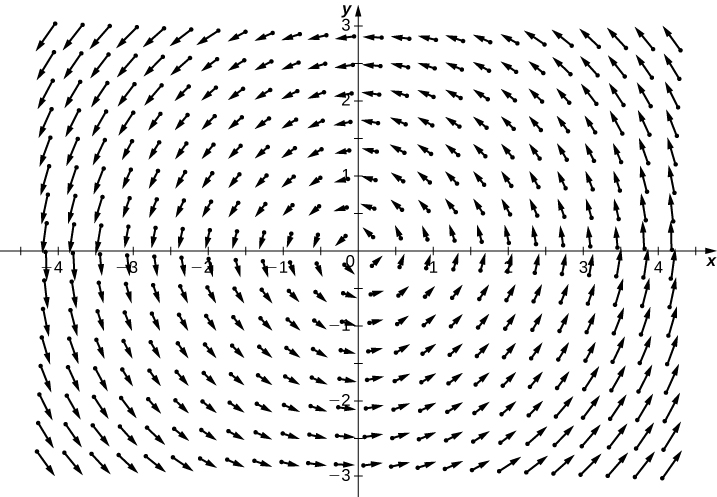
Hint
Substitute enough points into F to get an idea of the shape.
Velocity Field of a Fluid
Suppose that ![]() is the velocity field of a fluid. How fast is the fluid moving at betoken
is the velocity field of a fluid. How fast is the fluid moving at betoken ![]() (Presume the units of speed are meters per second.)
(Presume the units of speed are meters per second.)
To find the velocity of the fluid at signal ![]() substitute the indicate into v:
substitute the indicate into v:
![]()
The speed of the fluid at ![]() is the magnitude of this vector. Therefore, the speed is
is the magnitude of this vector. Therefore, the speed is ![]() one thousand/sec.
one thousand/sec.
Vector field ![]() models the velocity of water on the surface of a river. What is the speed of the h2o at bespeak
models the velocity of water on the surface of a river. What is the speed of the h2o at bespeak ![]() Use meters per second as the units.
Use meters per second as the units.
![]() k/sec
k/sec
Hint
Remember, speed is the magnitude of velocity.
Nosotros have examined vector fields that contain vectors of various magnitudes, but just as nosotros have unit vectors, we can also have a unit vector field. A vector field F is a unit of measurement vector field if the magnitude of each vector in the field is 1. In a unit vector field, the only relevant information is the direction of each vector.
A Unit of measurement Vector Field
Show that vector field ![]() is a unit vector field.
is a unit vector field.
To evidence that F is a unit field, we must show that the magnitude of each vector is i. Note that

Therefore, F is a unit vector field.
Is vector field ![]() a unit of measurement vector field?
a unit of measurement vector field?
No.
Hint
Calculate the magnitude of F at an capricious point ![]()
Why are unit vector fields important? Suppose nosotros are studying the flow of a fluid, and nosotros intendance only about the management in which the fluid is flowing at a given point. In this case, the speed of the fluid (which is the magnitude of the corresponding velocity vector) is irrelevant, because all we care well-nigh is the direction of each vector. Therefore, the unit vector field associated with velocity is the field nosotros would study.
If ![]() is a vector field, then the corresponding unit of measurement vector field is
is a vector field, then the corresponding unit of measurement vector field is ![]() Observe that if
Observe that if ![]() is the vector field from (Figure), and then the magnitude of F is
is the vector field from (Figure), and then the magnitude of F is ![]() and therefore the corresponding unit vector field is the field Grand from the previous example.
and therefore the corresponding unit vector field is the field Grand from the previous example.
If F is a vector field, then the process of dividing F past its magnitude to course unit vector field ![]() is chosen normalizing the field F.
is chosen normalizing the field F.
Vector Fields in 
We have seen several examples of vector fields in ![]() allow'southward now plough our attention to vector fields in
allow'southward now plough our attention to vector fields in ![]() These vector fields can be used to model gravitational or electromagnetic fields, and they can as well be used to model fluid flow or oestrus flow in three dimensions. A ii-dimensional vector field can really just model the move of h2o on a ii-dimensional slice of a river (such every bit the river'due south surface). Since a river flows through three spatial dimensions, to model the menstruation of the entire depth of the river, we need a vector field in iii dimensions.
These vector fields can be used to model gravitational or electromagnetic fields, and they can as well be used to model fluid flow or oestrus flow in three dimensions. A ii-dimensional vector field can really just model the move of h2o on a ii-dimensional slice of a river (such every bit the river'due south surface). Since a river flows through three spatial dimensions, to model the menstruation of the entire depth of the river, we need a vector field in iii dimensions.
The extra dimension of a iii-dimensional field can make vector fields in ![]() more difficult to visualize, simply the idea is the same. To visualize a vector field in
more difficult to visualize, simply the idea is the same. To visualize a vector field in ![]() plot enough vectors to show the overall shape. We tin use a like method to visualizing a vector field in
plot enough vectors to show the overall shape. We tin use a like method to visualizing a vector field in ![]() by choosing points in each octant.
by choosing points in each octant.
But equally with vector fields in ![]() we tin can stand for vector fields in
we tin can stand for vector fields in ![]() with component functions. We but demand an extra component function for the extra dimension. We write either
with component functions. We but demand an extra component function for the extra dimension. We write either
![]()
or
![]()
Sketching a Vector Field in Three Dimensions
Describe vector field ![]()
For this vector field, the x and y components are constant, and then every point in ![]() has an associated vector with x and y components equal to one. To visualize F, we get-go consider what the field looks similar in the xy-plane. In the xy-plane,
has an associated vector with x and y components equal to one. To visualize F, we get-go consider what the field looks similar in the xy-plane. In the xy-plane, ![]() Hence, each point of the form
Hence, each point of the form ![]() has vector
has vector ![]() associated with it. For points non in the xy-aeroplane but slightly above information technology, the associated vector has a small but positive z component, and therefore the associated vector points slightly upward. For points that are far above the xy-plane, the z component is large, so the vector is most vertical. (Figure) shows this vector field.
associated with it. For points non in the xy-aeroplane but slightly above information technology, the associated vector has a small but positive z component, and therefore the associated vector points slightly upward. For points that are far above the xy-plane, the z component is large, so the vector is most vertical. (Figure) shows this vector field.
A visual representation of vector field ![]()

Sketch vector field ![]()

Hint
Substitute enough points into the vector field to get an thought of the general shape.
In the next instance, nosotros explore 1 of the classic cases of a 3-dimensional vector field: a gravitational field.
Since object 1 is located at the origin, the distance between the objects is given by ![]() The unit vector from object 1 to object 2 is
The unit vector from object 1 to object 2 is ![]() and hence
and hence ![]() Therefore, gravitational vector field F exerted by object one on object 2 is
Therefore, gravitational vector field F exerted by object one on object 2 is
![]()
This is an example of a radial vector field in ![]()
(Figure) shows what this gravitational field looks like for a large mass at the origin. Note that the magnitudes of the vectors increase equally the vectors go closer to the origin.
A visual representation of gravitational vector field ![]() for a large mass at the origin.
for a large mass at the origin.
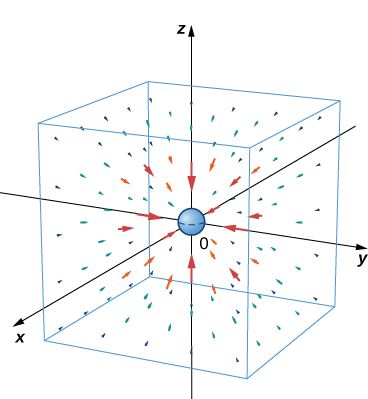
The mass of asteroid 1 is 750,000 kg and the mass of asteroid 2 is 130,000 kg. Assume asteroid i is located at the origin, and asteroid ii is located at ![]() measured in units of 10 to the eighth power kilometers. Given that the universal gravitational constant is
measured in units of 10 to the eighth power kilometers. Given that the universal gravitational constant is ![]() observe the gravitational force vector that asteroid ane exerts on asteroid ii.
observe the gravitational force vector that asteroid ane exerts on asteroid ii.
![]()
Hint
Follow (Figure) and first compute the distance between the asteroids.
Gradient Fields
In this section, nosotros study a special kind of vector field chosen a slope field or a bourgeois field. These vector fields are extremely important in physics considering they can be used to model concrete systems in which energy is conserved. Gravitational fields and electric fields associated with a static charge are examples of slope fields.
Think that if ![]() is a (scalar) function of x and y, then the slope of
is a (scalar) function of x and y, then the slope of ![]() is
is
![]()
We can see from the form in which the slope is written that ![]() is a vector field in
is a vector field in ![]() Similarly, if
Similarly, if ![]() is a function of x, y, and z, then the slope of
is a function of x, y, and z, then the slope of ![]() is
is
![]()
The gradient of a iii-variable function is a vector field in ![]()
A gradient field is a vector field that can be written as the gradient of a role, and nosotros take the following definition.
Sketching a Slope Vector Field
Use technology to plot the gradient vector field of ![]()
The gradient of ![]() is
is ![]() To sketch the vector field, employ a estimator algebra organisation such every bit Mathematica. (Effigy) shows
To sketch the vector field, employ a estimator algebra organisation such every bit Mathematica. (Effigy) shows ![]()
The gradient vector field is ![]() where
where ![]()
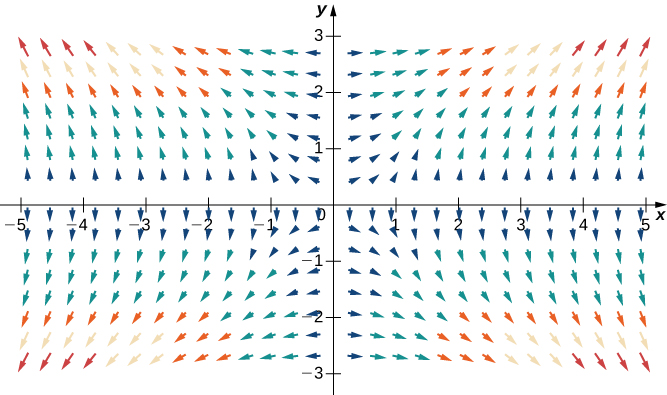
Employ technology to plot the gradient vector field of ![]()
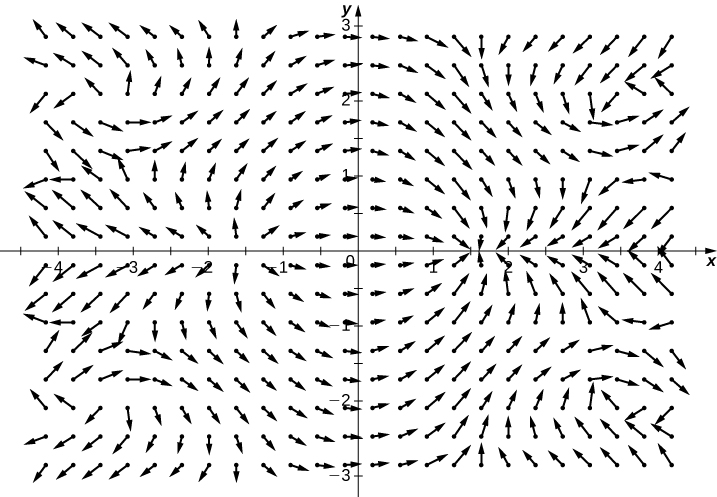
Hint
Observe the slope of ![]()
Consider the function ![]() from (Figure). (Figure) shows the level curves of this role overlaid on the function'south gradient vector field. The gradient vectors are perpendicular to the level curves, and the magnitudes of the vectors get larger as the level curves go closer together, because closely grouped level curves bespeak the graph is steep, and the magnitude of the gradient vector is the largest value of the directional derivative. Therefore, you lot can see the local steepness of a graph by investigating the corresponding office's gradient field.
from (Figure). (Figure) shows the level curves of this role overlaid on the function'south gradient vector field. The gradient vectors are perpendicular to the level curves, and the magnitudes of the vectors get larger as the level curves go closer together, because closely grouped level curves bespeak the graph is steep, and the magnitude of the gradient vector is the largest value of the directional derivative. Therefore, you lot can see the local steepness of a graph by investigating the corresponding office's gradient field.
The gradient field of ![]() and several level curves of
and several level curves of ![]() Notice that as the level curves become closer together, the magnitude of the slope vectors increases.
Notice that as the level curves become closer together, the magnitude of the slope vectors increases.
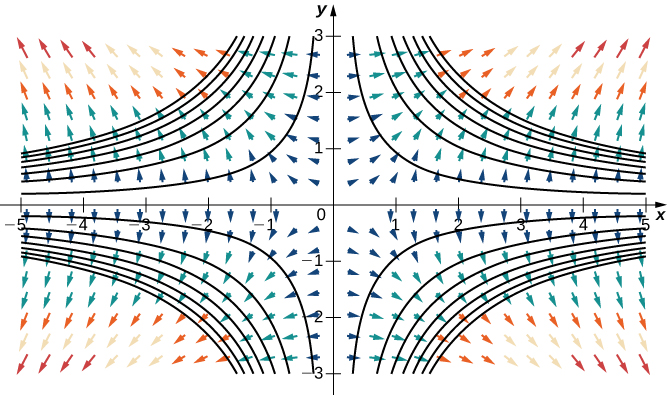
As we learned earlier, a vector field ![]() is a bourgeois vector field, or a gradient field if at that place exists a scalar function
is a bourgeois vector field, or a gradient field if at that place exists a scalar function ![]() such that
such that ![]() In this situation,
In this situation, ![]() is called a potential role for
is called a potential role for ![]() Conservative vector fields arise in many applications, particularly in physics. The reason such fields are called conservative is that they model forces of physical systems in which energy is conserved. We study bourgeois vector fields in more detail later in this affiliate.
Conservative vector fields arise in many applications, particularly in physics. The reason such fields are called conservative is that they model forces of physical systems in which energy is conserved. We study bourgeois vector fields in more detail later in this affiliate.
You lot might notice that, in some applications, a potential role ![]() for F is defined instead as a function such that
for F is defined instead as a function such that ![]() This is the case for certain contexts in physics, for example.
This is the case for certain contexts in physics, for example.
Verifying a Potential Role
Is ![]() a potential function for vector field
a potential function for vector field
![]()
We need to confirm whether ![]() We have
We have
![]()
Therefore, ![]() and
and ![]() is a potential office for
is a potential office for ![]()
Is ![]() a potential function for
a potential function for ![]()
No
Hint
Compute the gradient of ![]()
Verifying a Potential Function
The velocity of a fluid is modeled by field ![]() Verify that
Verify that ![]() is a potential function for v.
is a potential function for v.
Verify that ![]() is a potential role for velocity field
is a potential role for velocity field ![]()
![]()
Hint
Calculate the gradient.
If F is a bourgeois vector field, then there is at least one potential function ![]() such that
such that ![]() Just, could there be more than than one potential function? If so, is in that location whatever relationship between two potential functions for the aforementioned vector field? Before answering these questions, let'due south recall some facts from unmarried-variable calculus to guide our intuition. Recall that if
Just, could there be more than than one potential function? If so, is in that location whatever relationship between two potential functions for the aforementioned vector field? Before answering these questions, let'due south recall some facts from unmarried-variable calculus to guide our intuition. Recall that if ![]() is an integrable role, then one thousand has infinitely many antiderivatives. Furthermore, if F and Chiliad are both antiderivatives of k, then F and G differ just past a constant. That is, in that location is some number C such that
is an integrable role, then one thousand has infinitely many antiderivatives. Furthermore, if F and Chiliad are both antiderivatives of k, then F and G differ just past a constant. That is, in that location is some number C such that ![]()
Now let F be a conservative vector field and let ![]() and one thousand be potential functions for F. Since the gradient is similar a derivative, F being conservative means that F is "integrable" with "antiderivatives"
and one thousand be potential functions for F. Since the gradient is similar a derivative, F being conservative means that F is "integrable" with "antiderivatives" ![]() and m. Therefore, if the analogy with unmarried-variable calculus is valid, we expect there is some constant C such that
and m. Therefore, if the analogy with unmarried-variable calculus is valid, we expect there is some constant C such that ![]() The next theorem says that this is indeed the case.
The next theorem says that this is indeed the case.
To state the side by side theorem with precision, we need to assume the domain of the vector field is continued and open. To be continued ways if ![]() and
and ![]() are any two points in the domain, then you lot tin walk from
are any two points in the domain, then you lot tin walk from ![]() to
to ![]() along a path that stays entirely inside the domain.
along a path that stays entirely inside the domain.
Uniqueness of Potential Functions
Let F be a conservative vector field on an open and connected domain and permit ![]() and g be functions such that
and g be functions such that ![]() and
and ![]() Then, there is a constant C such that
Then, there is a constant C such that ![]()
Proof
Since F is conservative, there is a function ![]() such that
such that ![]() Therefore, past the definition of the gradient,
Therefore, past the definition of the gradient, ![]() and
and ![]() By Clairaut's theorem,
By Clairaut's theorem, ![]() But,
But, ![]() and
and ![]() and thus
and thus ![]()
□
Clairaut's theorem gives a fast proof of the cantankerous-fractional belongings of conservative vector fields in ![]() simply as it did for vector fields in
simply as it did for vector fields in ![]()
(Figure) shows that well-nigh vector fields are not conservative. The cross-partial property is difficult to satisfy in general, so most vector fields won't have equal cross-partials.
Evidence that vector field ![]() is not bourgeois.
is not bourgeois.
![]()
Hint
Check the cross-partials.
Is vector field ![]() conservative?
conservative?
No
Hint
Cheque the cross-partials.
We conclude this department with a word of warning: (Figure) says that if F is conservative, then F has the cross-fractional property. The theorem does not say that, if F has the cross-fractional belongings, then F is conservative (the converse of an implication is not logically equivalent to the original implication). In other words, (Effigy) can simply assist determine that a field is non bourgeois; it does not permit yous conclude that a vector field is bourgeois. For case, consider vector field ![]() This field has the cross-fractional property, so it is natural to attempt to utilise (Figure) to conclude this vector field is bourgeois. Nonetheless, this is a misapplication of the theorem. We acquire later on how to conclude that F is bourgeois.
This field has the cross-fractional property, so it is natural to attempt to utilise (Figure) to conclude this vector field is bourgeois. Nonetheless, this is a misapplication of the theorem. We acquire later on how to conclude that F is bourgeois.
Primal Concepts
Key Equations
The domain of vector field ![]() is a set of points
is a set of points ![]() in a plane, and the range of F is a set up of what in the plane?
in a plane, and the range of F is a set up of what in the plane?
Vectors
For the following exercises, determine whether the statement is true or false.
Vector field ![]() is constant in direction and magnitude on a unit circle.
is constant in direction and magnitude on a unit circle.
False
Vector field ![]() is neither a radial field nor a rotation.
is neither a radial field nor a rotation.
For the following exercises, describe each vector field by cartoon some of its vectors.
[T] ![]()

[T] ![]()
[T] ![]()

[T] ![]()
[T] ![]()
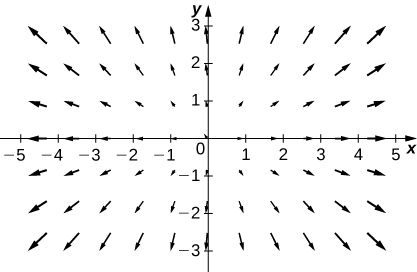
[T] ![]()
[T] ![]()

[T] ![]()
[T] ![]()
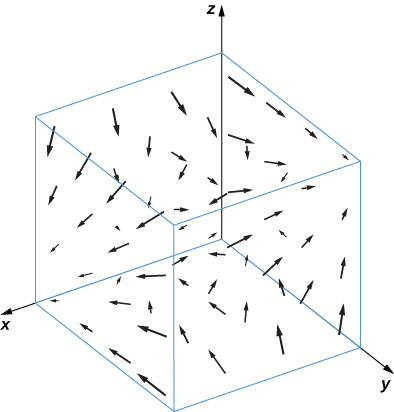
[T] ![]()
For the post-obit exercises, find the gradient vector field of each part ![]()
![]()
![]()
![]()
![]()
![]()
![]()
![]()
![]()
![]()
What is vector field ![]() with a value at
with a value at ![]() that is of unit length and points toward
that is of unit length and points toward ![]()
![]()
For the following exercises, write formulas for the vector fields with the given properties.
All vectors are parallel to the ten-centrality and all vectors on a vertical line take the same magnitude.
All vectors betoken toward the origin and take abiding length.
![]()
All vectors are of unit length and are perpendicular to the position vector at that point.
Is vector field ![]() a slope field?
a slope field?
Detect a formula for vector field ![]() given the fact that for all points
given the fact that for all points ![]() F points toward the origin and
F points toward the origin and ![]()
![]()
For the post-obit exercises, assume that an electric field in the xy-plane acquired by an infinite line of charge along the x-axis is a gradient field with potential part ![]() where
where ![]() is a constant and
is a constant and ![]() is a reference distance at which the potential is assumed to be cypher.
is a reference distance at which the potential is assumed to be cypher.
Find the components of the electric field in the 10– and y-directions, where ![]()
Testify that the electric field at a point in the xy-aeroplane is directed outward from the origin and has magnitude ![]() where
where ![]()
![]()
A flow line (or streamline) of a vector field ![]() is a curve
is a curve ![]() such that
such that ![]() If
If ![]() represents the velocity field of a moving particle, then the flow lines are paths taken by the particle. Therefore, flow lines are tangent to the vector field. For the post-obit exercises, show that the given curve
represents the velocity field of a moving particle, then the flow lines are paths taken by the particle. Therefore, flow lines are tangent to the vector field. For the post-obit exercises, show that the given curve ![]() is a flow line of the given velocity vector field
is a flow line of the given velocity vector field ![]()
![]()
![]()
![]()
For the following exercises, let ![]()
![]() and
and ![]() Friction match F, Chiliad, and H with their graphs.
Friction match F, Chiliad, and H with their graphs.
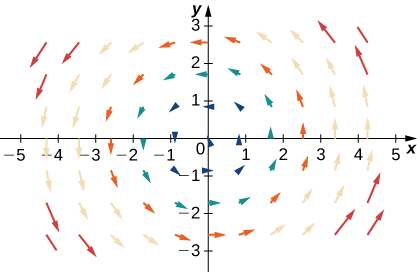
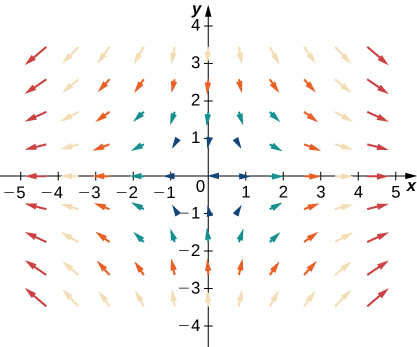
H
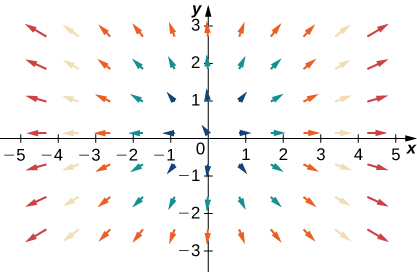
For the following exercises, let ![]()
![]() and
and ![]() Match the vector fields with their graphs in
Match the vector fields with their graphs in ![]()
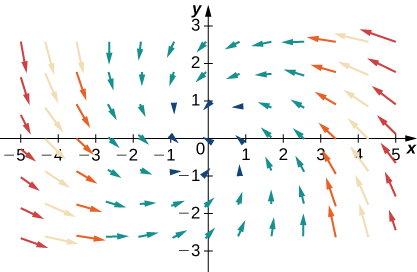
d. ![]()
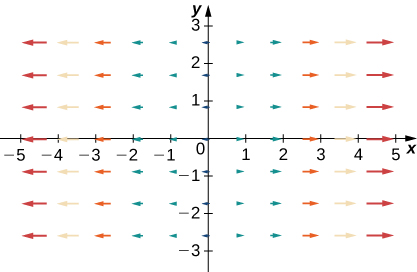
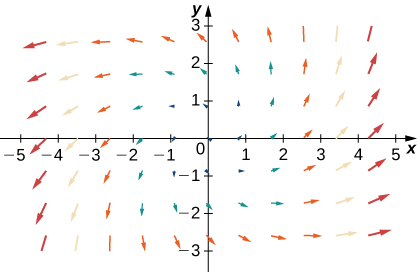
a. ![]()
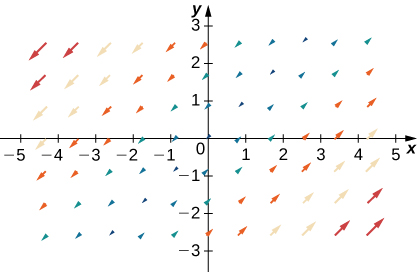
bennettplefuspritir.blogspot.com
Source: https://opentextbc.ca/calculusv3openstax/chapter/vector-fields/
0 Response to "Our Answer Is Partially Correct Try Again For the Following Three Vectors What Is ?"
Post a Comment